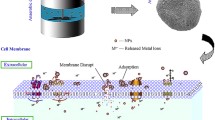Abstract
The unique properties and growing usage of zinc oxide nanoparticles increase their release in municipal wastewater treatment plants. Therefore, these nanoparticles, by interacting with microorganisms, can fail the suitable functioning of biological systems in treatment plants. For this reason, research into the toxicity of ZnO is urgent. In the present study, the toxicity mechanism of ZnO-NPs towards microbial communities central to granular activated sludge (GAS) performance was assessed over 120-day exposure. The results demonstrate that the biotoxicity of ZnO-NPs is dependent upon its dosage, exposure time, and the extent of reactive oxygen species (ROS) production. Furthermore, GAS performance and the extracellular polymeric substances (EPS) content were significantly reduced at 50 mg/L ZnO-NPs. This exposure led to decreases in the activity of ammonia monooxygenase (25.2%) and nitrate reductase (11.9%) activity. The Field emission scanning electron microscopy images confirmed that ZnO-NPs were able to disrupt the cell membrane integrity and lead to cell/bacterial death via intracellular ROS generation which was confirmed by the Confocal Laser Scanning Microscopy analysis. After exposure to the NPs, the bacterial community composition shifted to one dominated by Gram-positive bacteria. The results of this study could help to develop environmental standards and regulations for NPs applications and emissions.

Similar content being viewed by others
References
Arnaout C L (2012). Assessing the Impacts of Silver Nanoparticles on the Growth, Diversity, and Function of Wastewater Bacteria, Dissertation for the Doctoral Degree. Durham: Duke University
APHA 2005. Standard Methods for the Examination of Water and Wastewater, Washington, DC: American Public Health Association
Corry B (2008). Designing carbon nanotube membranes for efficient water desalination. Journal of Physical Chemistry B, 112(5): 1427–1434
Chen Y, Su Y, Zheng X, Chen H, Yang H (2012). Alumina nanoparticles-induced effects on wastewater nitrogen and phosphorus removal after short-term and long-term exposure. Water Research, 46(14): 4379–4386
Choi O, Clevenger T E, Deng B, Surampalli R L, Ross J L Jr, Hu Z (2009). Role of sulfide and ligand strength in controlling nanosilver toxicity. Water Research, 43(7): 1879–1886
Daraei H, Rafiee M, Yazdanbakhsh A R, Amoozegar M A, Guanglei Q (2019). A comparative study on the toxicity of nanozero valent iron (nZVI) on aerobic granular sludge and flocculent activated sludge: Reactor performance, microbial behavior, and mechanism of toxicity. Process Safety and Environmental Protection, 129: 238–248
Daraei H, Manshouri M, Yazdanbakhhsh A R (2010). Removal of phenol from aqueous solution using ostrich feather ash. Majallah-i Danishgah-i Ulum-i Pizishki-i Mazandaran, 20(79): 81–87
Decker T, Lohmann-Matthes M L (1988). A quick and simple method for the quantitation of lactate dehydrogenase release in measurements of cellular cytotoxicity and tumor necrosis factor (TNF) activity. Journal of Immunological Methods, 115(1): 61–69
Deng S H, Wang L, Su H (2016). Role and influence of extracellular polymeric substances on the preparation of aerobic granular sludge. Journal of Environmental Management, 173: 49–54
Gottschalk F, Sonderer T, Scholz R W, Nowack B (2009). Modeled environmental concentrations of engineered nanomaterials (TiO2, ZnO, Ag, CNT, fullerenes) for different regions. Environmental Science & Technology, 43(24): 9216–9222
Gonzalez-Estrella J, Sierra-Alvarez R, Field A J (2013). Toxicity assessment of inorganic nanoparticles to acetoclastic and hydrogenotrophic methanogenic activity in anaerobic granular sludge. Journal of Hazardous Materials, 260: 278–285
Jiang H, Mashayekhi W, Xing B (2009). Bacterial toxicity comparison between nano- and micro-scaled oxide particles. Environmental Pollution, 157(5): 1619–1625
Kaegi R, Voegelin A, Sinnet B, Zuleeg S, Hagendorfer H, Burkhardt M, Siegrist H (2011). Behavior of metallic silver nanoparticles in a pilot wastewater treatment plant. Environmental Science & Technology, 45(9): 3902–3908
Kiser M A, Ryu H, Jang H Y, Hristovski K, Westerhoff P (2010). Biosorption of nanoparticles to heterotrophic wastewater biomass. Water Research, 44(14): 4105–1114
Kim B, Park C S, Murayama M, Hochella M F Jr (2010). Discovery and characterization of silver sulphide nanoparticles in final sewage sludge products. Environmental Science & Technology, 44(19): 7509–7514
Labbé N, Parent S, Villemur R (2003). Addition of trace metals increases denitrification rate in closed marine systems. Water Research, 37(4): 914–920
Li Z, Wang X, Ma B, Wang S, Zheng D, She Z, Guo L, Zhao Y, Xu Q, Jin C, Li S, Gao M (2017). Long-term impacts of titanium dioxide nanoparticles (TiO2 NPs) on performance and microbial community of activated sludge. Bioresource Technology, 238: 361–368
Li H, Shen T T, Wang X L, Lin K F, Liu Y D, Lu S G, Gu J D, Wang P, Lu Q, Du X M (2013). Biodegradation of perchloroethylene and chlorophenol co-contamination and toxic effect on activated sludge performance. Bioresource Technology, 137: 286–293
Liang Z H, Das A, Hu Z Q (2010). Bacterial response to a shock load of nanosilver in an activated sludge treatment system. Water Research, 44(18): 5432–5438
Marcilhac C, Sialve B, Pourcher A M, Ziebal C, Bernet N, Beline F (2014). Digestate color and light intensity affect nutrient removal and competition phenomena in a microalgal-bacterial ecosystem. Water Research, 64: 278–287
Mu H, Zheng X, Chen Y, Chen H, Liu K (2012). Response of anaerobic granular sludge to a shock load of zinc oxide nanoparticles during biological wastewater treatment. Environmental Science & Technology, 46(11): 5997–6003
Mu H, Chen Y G (2011). Long-term effect of ZnO nanoparticles on waste activated sludge anaerobic digestion. Water Research, 45(17): 5612–5620
Ni S Q, Ni J, Yang N, Wang J (2013). Effect of magnetic nanoparticles on the performance of activated sludge treatment system. Bioresource Technology, 143: 555–561
Quan X, Cen Y, Lu F, Gu L, Ma J (2015). Response of aerobic granular sludge to the long-term presence to nanosilver in sequencing batch reactors: reactor performance, sludge property, microbial activity and community. Science of the Total Environment, 506–507: 226–233
Sheng G P, Yu H Q, Li X Y (2010). Extracellular polymeric substances (EPS) of microbial aggregates in biological wastewater treatment systems: A review. Biotechnology Advances, 28(6): 882–894
Sirelkhatim A, Mahmud S, Seeni A, Kaus NHM, Ann L C, Bakhori S K M, Hasan H, Mohamad D (2015). Review on zinc oxide nanoparticles: Antibacterial activity and toxicity mechanism. Nano-Micro Letters, 7(3): 219–242
Siddiqi K S, ur Rahman A, Tajuddin, Husen A (2018). Properties of zinc oxide nanoparticles and their activity against microbes. Nanoscale Research Letters, 13(1): 141–148
Tan M, Qiu G, Ting Y.P (2015). Effects of ZnO nanoparticles on wastewater treatment and their removal behavior in a membrane bioreactor. Bioresource Technology, 185: 125–133
Weinberg F, Hamanaka R, Wheaton W W, Weinberg S, Joseph J, Lopez M, Kalyanaraman B, Mutlu G M, Budinger G R S, Chandel N S (2010). Mitochondrial metabolism and ROS generation are essential for mediated tumorigenicity. Proceedings of the National Academy of Sciences of the United States of America, 107(19): 8788–8793
Yazdanbakhsh A R, Rafiee M, Daraei H, Amoozegar M A (2019). Responses of flocculated activated sludge to bimetallic Ag-Fe nanoparticles toxicity: Performance, activity enzymatic, and bacterial community shift. Journal of Hazardous Materials, 366: 114–123
Yamamoto O, Komatsu M, Sawai J, Nakagawa Z E (2004). Effect of lattice constant of zinc oxide on antibacterial characteristics. Journal of Materials Science. Materials in Medicine, 15(8): 847–851
Yang Y, Wang J, Xiu Z, Alvarez P J (2013). Impacts of silver nanoparticles on cellular and transcriptional activity of nitrogencycling bacteria. Environmental Toxicology and Chemistry, 32(7): 1488–1494
Zheng X, Wu R, Chen Y (2011). Effects of ZnO nanoparticles on wastewater biological nitrogen and phosphorus removal. Environmental Science & Technology, 45(7): 2826–2832
Zheng Y M, Yu H Q, Liu S H, Liu X Z (2006). Formation and instability of aerobic granules under high organic loading conditions. Chemosphere, 63(10): 1791–1800
Acknowledgements
This work was supported by the vice-chancellor for Research and Technology of Kerman University of Medical Sciences (Grant No. 98001185) and the code of research ethics certificate IR.KMU. REC.1399.415. The authors would like to thank the Environmental Health Engineering Research Center, the Kerman University of Medical Sciences, for their scientific supports.
Author information
Authors and Affiliations
Corresponding author
Additional information
Highlights
• ZnO-NP disrupted metabolic/catabolic balance of bacteria by affecting DHA activity.
• ZnO-NPs toxicity was related to Zn ion, interaction with cell and ROS generation.
• Exposure to ZnO-NPs resulted in changed bacterial community structure at sludge.
• The change in the EPS content was observed during exposure to ZnO-NPs.
Rights and permissions
About this article
Cite this article
Daraei, H., Toolabian, K., Thompson, I. et al. Biotoxicity evaluation of zinc oxide nanoparticles on bacterial performance of activated sludge at COD, nitrogen, and phosphorus reduction. Front. Environ. Sci. Eng. 16, 19 (2022). https://doi.org/10.1007/s11783-021-1453-z
Received:
Revised:
Accepted:
Published:
DOI: https://doi.org/10.1007/s11783-021-1453-z




